Machine Learning for Asset-Intensive Industries
by Eli Jordan, on March 8, 2021
Overview
Machine learning is proving to be an effective technology in asset-intensive industries, offering new insights that can be used to optimize production phases, reduce equipment downtime, and increase quality. But, as more and more organizations begin to integrate Internet of Things (IoT) and machine learning platforms into their business, it can feel like uncharted territory that requires expensive software and new human talent.
In this application note, we’ll discuss some of the challenges currently faced by organizations as they look to incorporate this technology. We will also identify how Exosite’s ExoSense® remote monitoring application can be paired with Boon Logic’s Amber Analytics technology to quickly augment existing equipment and systems with machine learning capabilities to improve performance, optimize operations, and increase profits.
The Challenges
Organizations in asset-intensive industries often face common challenges as they consider incorporating IoT and machine learning technology:
- Developing and maintaining a “smart” solution can be complicated and include hidden maintenance costs for things like data storage, upgrades, testing, and more.
- Building a data science team to incorporate machine learning can require significant time and financial resources.
- No two assets are identical, so generalized machine learning models included with software often do not capture anomalies to a high enough degree of precision and accuracy.
- The leading indicators of asset malperformance can be subtle and not adhere to the timelines specified by a manufacturer’s part replacement guidelines or engineering know-how.
- Once malperformance models are in place, they often need to be manually re-trained frequently to ensure effectiveness.
The Solution
Exosite’s ExoSense® application is ideal for organizations in asset-intensive industries looking to augment existing systems and equipment with remote monitoring and machine learning capabilities. ExoSense is a fully managed software solution that can be deployed in a matter of minutes and, through Exosite’s partnership with Boon Logic, gives users access to machine learning technology that can be tuned, trained, and run autonomously.
Once connected, equipment can begin sending sensor data to the Exosite cloud. There, operators and maintenance personnel can use the ExoSense application to remotely view dashboards with real-time sensor data showing equipment health and status.
That data can then be natively integrated with Boon Logic’s segmentation algorithm through use of the Amber Analytics Insight available in Exosite’s Exchange IoT marketplace.
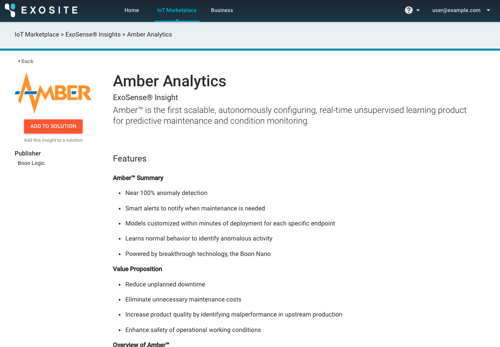
Once added to a user’s ExoSense instance, the Insight is accessed through an intuitive and codeless visual interface where it can be added onto a sensor data stream just like any other Transform or Rule available within the application.
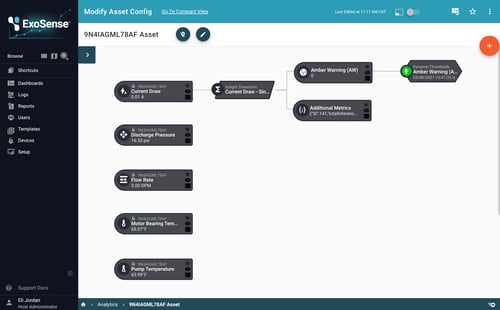
The Insight processes data points (inferences) streamed through from one or more sensors (features) to quantify relationships and build associations. Behind the scenes, bounds, percent variations, and overall patterns of behavior are identified, with sufficiently unique sets of patterns being grouped together within their own cluster (ID).
In the beginning, the number of clusters grows quickly as new data is processed. As the model matures and variations are learned, incoming patterns can be assigned to an existing cluster and the growth rate slows.
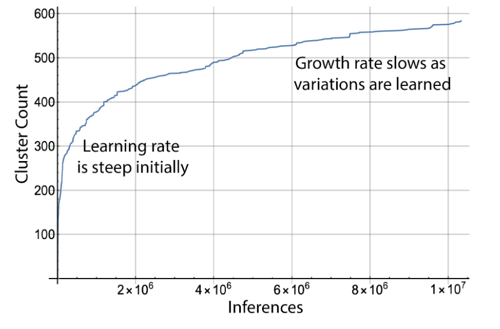
Each cluster of patterns is assigned an anomaly index, which provides insight into how commonly they occur. Index values close to zero identify very common patterns, while values closer to 1000 identify those less common. The overall spread within the clusters is used to determine a "threshold" at which a given pattern would be flagged as an anomaly.
For example, in a use-case with a lower degree of variation, index values above 650 are flagged as anomalous. However, in a separate case with a higher degree of variation identified, only index values above 800 would be flagged.

Raw sensor data (in blue) is viewed on the Anomaly Index (in orange),
which identifies a rare pattern in the data
Although individual assets of the same type may share a majority of their general properties, there are always subtle, often imperceptible, differences. The Amber Analytics Insight, used on a per-asset basis, creates individualized models of performance that are able to account for those subtleties and maximize its detection accuracy.
The Insight also enables an automatic progression through the stages of training and into monitoring for new asset-level models. With only a few configuration settings defined at the outset and no requirements for a big preexisting data set or in-depth understanding of machine learning, getting started and scaling are both made easy.
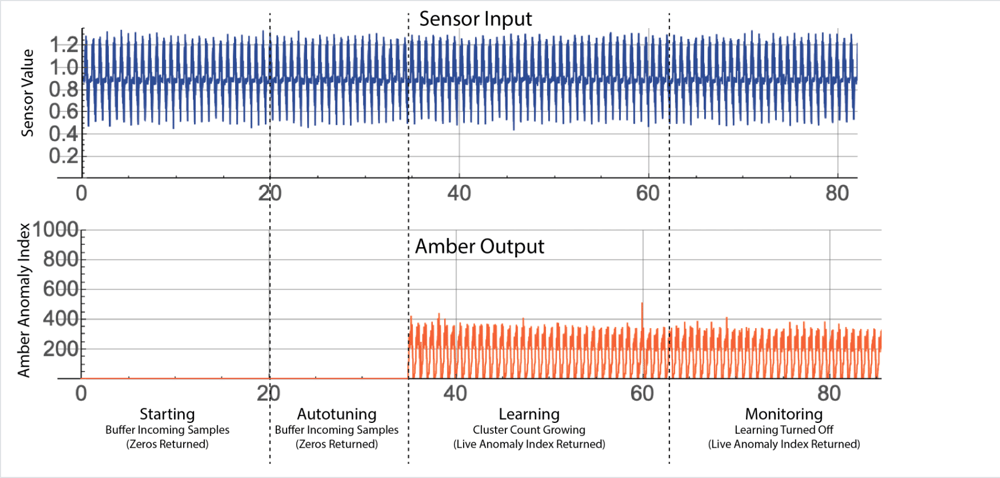
Raw sensor data (in blue) is viewed in Amber’s
four-phased process (in orange)
One of the core outputs from the Amber Analytics Insight is the Amber Warning (AW). For each inference processed, the resulting AW value may be one of three possibilities: 0, 1, or 2, representing the detection of no anomalies, a moderate amount of anomalies, or a severe trend of anomalies respectively.
The Dynamic Threshold Rule provided by ExoSense can quickly be configured to trigger Normal, Warning, or Critical states on these values, with each state tying into the application’s visualizations. The states can also trigger text and/or email notifications to subscribed users. As a result, operators and maintenance personnel can be notified well in advance of mechanical issues, enabling proactive maintenance and optimized productivity.
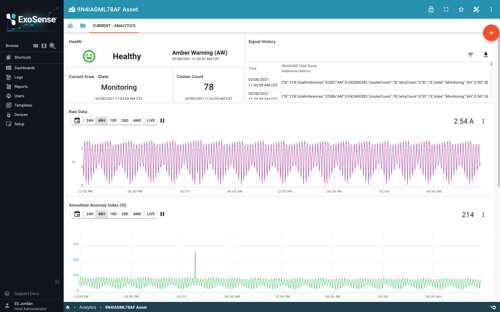
For those interested in a higher level of detail, the Amber Analytics Insight also provides a collection of contextual information and more raw-form, analytic metrics that can be parsed-out for enhanced visualization and alerting.
Key ExoSense Features
ExoSense provides the following features that are purpose-built for use in asset-intensive use cases:
- Drag-and-drop dashboards for real-time visualization of metrics like temperature, output current, torque trim, position, velocity, etc.
- Machine learning capabilities, including automatic model training, parameter tuning, automatic anomaly detection, and individual asset-level models for maximum detection accuracy.
- Customizable rules to trigger real-time SMS and email alerts about anomalies 24 hours a day.
- Inherent, industry-accepted security standards for device and system connectivity.
- Image overlay panels that enable real-life visualization of assets within facilities to quickly pinpoint problem assets and location.
- Hardware-agnostic connections to prevent vendor lock-in and provide the flexibility to select the best sensors for every project.
For a more in-depth look at all of the features ExoSense has to offer, visit our technical documentation site.
The Outcomes
Organizations leveraging ExoSense have been able to:
- Minimize startup and ongoing costs associated with remote monitoring and machine learning. As a production-ready solution, ExoSense includes the ongoing maintenance, updates, and technical support users need to leverage remote monitoring and machine learning without having to develop a solution, manage it, or hire new talent.
- Identify leading indicators of asset malperformance with near 100% accuracy. By creating individualized models of normal performance for each asset, organizations are able to maximize the identification of anomalous behavior that leads to malperformance. For example, a subtle shift in the relationship between current, rotational speed, and frequency can indicate a change in asset performance long before it can be detected by classical threshold-based approaches.
- Eliminate unplanned downtime, reduce maintenance costs, and enable proactive maintenance. Paired with Boon Logic’s machine learning technology, ExoSense enables support personnel to better anticipate mechanical issues, maintain inventory of critical parts, and perform maintenance before downtime occurs.
- Optimize asset performance and enhance safety of working conditions. With greater insight into asset health, operators can enhance the life cycle of their assets, improve productivity, and ultimately generate a greater return on investment. They are also able to reduce hazards associated with equipment malfunction, resulting in safer working conditions and fewer catastrophic incidents.



